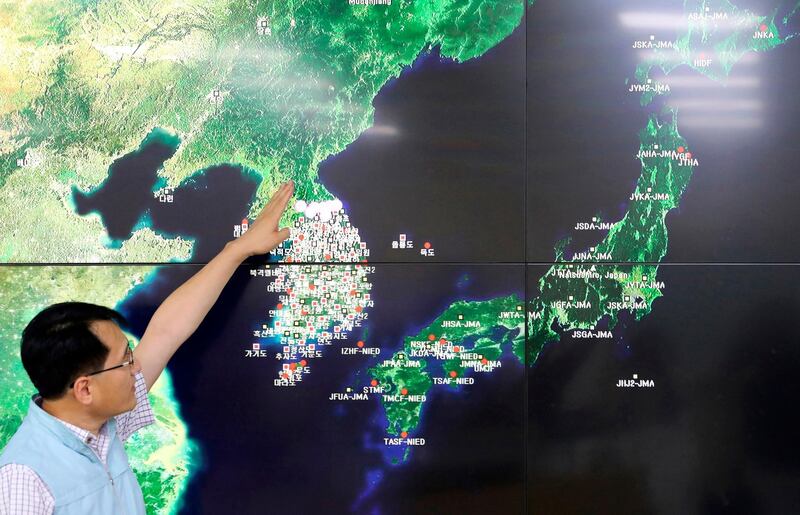The mountain above North Korea's main nuclear testing site has likely collapsed after a test last year, rendering it unsafe for further use and requiring that it be monitored for any leaking radiation, according to a study by Chinese geologists.
The findings shed new light on North Korean leader Kim Jong-un's announcement on Saturday that his country would halt its testing programme ahead of planned meetings with the South Korean and US presidents.
The study by scientists at the University of Science and Technology of China supports some of the findings of another group of Chinese researchers that was published last month by the journal Geophysical Research Letters.
The data in the latest Chinese study was collected following the most powerful of North Korea's six nuclear tests on September 3, which is believed to have triggered four earthquakes over the following weeks. The yield of the bomb was estimated at more than 100 kilotons of TNT, at least 10 times stronger than anything the North had tested previously. In comparison, the US bomb dropped on Hiroshima in 1945 had a yield of about 15 kilotons.
The first of those earthquakes, which occurred 8 and a half minutes after the explosion, was "an onsite collapse toward the nuclear test centre," while those that followed were an "earthquake swarm" in similar locations, according to the University of Science and Technology of China paper, authored by Tian Dongdong, Yao Jiawen and Wen Lianxing.
Nuclear explosions release enormous amounts of heat and energy, and the North's test in September was believed early on to have rendered the Punggye-ri testing site in north-eastern North Korea unstable.
"In view of the research finding that the North Korea nuclear test site at Mantapsan has collapsed, it is necessary to continue to monitor any leakage of radioactive materials that may have been caused by the collapse," the authors said in a summary posted on the university's website.
The study is peer-reviewed and has been accepted for publication by the journal Geophysical Research Letters.
_______________
Read more:
Kim Jong-un has no incentive to denuclearise. The sooner Trump realises that, the better
The summit of the two Koreas is the first act in a two-part play
_______________
The Chinese study makes sense and is based on well understood research, said Rowena Lohman, a seismologist at Cornell University who was not part of the work. She said she believes there is an international effort that monitors these tests for radiation.
Chinese authorities have said they have detected no radiation risk from samples collected along the border.
A study published last month by the journal, authored by a team led by Liu Junqing at the earthquake bureau in Jilin province bordering North Korea, found similar results of the September 3 explosion. It described the aftershock that followed seconds later as most likely a "rapid destruction of an explosion-generated cracked rock chimney due to cavity collapse".
North Korea's nuclear tests are of special concern to Beijing, since the test site near the town of Kilju is less than 100 kilometres from the border with China.
North Korean nuclear tests have caused seismic events in Chinese border towns and cities, forcing evacuations of schools and offices, sparking fears of wind-borne radiation and leading to a backlash among some Chinese against their country's unpredictable traditional ally.
Ties between the sides have been deteriorating for years, although Mr Kim made a long-anticipated visit to Beijing last month after China's implementation of United Nations economic sanctions reduced trade between them by as much as 90 per cent.
The quakes that followed the September test were not man-made and did not appear to cause any damage in the area. The region is not one where earthquakes naturally occur and no quakes were detected after the five smaller nuclear tests North Korea has conducted since 2006.
Kune Yull Suh, a professor of nuclear engineering at Seoul National University, warned last year that further tests could threaten to cause a volcanic eruption at Mount Paektu, which is about 100km away.
On Saturday, North Korea announced it will close its nuclear testing facility and suspend nuclear and intercontinental ballistic missile tests — a move welcomed by US President Donald Trump as "big progress" — and which comes ahead of the planned summit between him and Mr Kim.
However, the North stopped short of suggesting it will give up its nuclear weapons or scale back its production of missiles and their related components.





